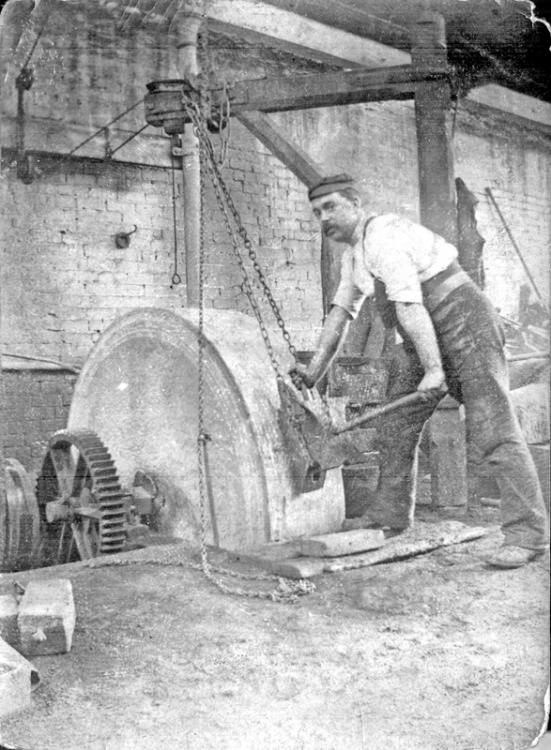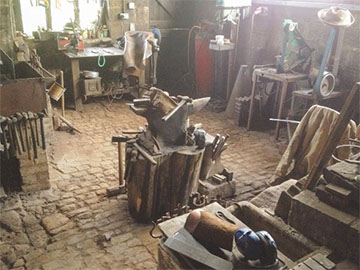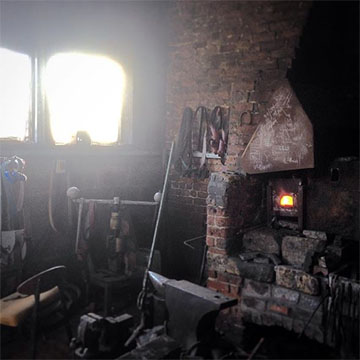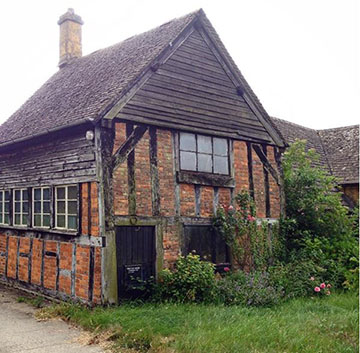
Dan P.
Members-
Posts
720 -
Joined
-
Last visited
Content Type
Profiles
Forums
Articles
Gallery
Downloads
Events
Everything posted by Dan P.
-
I think improving your manners must not have been on your new year's resolution list, which is a shame, because they are shabby. And, for your information, it was Thiers grinders who lay on their stomachs to grind. Sheffield grinders sat, and still do, on a saddle, called a "horsing". I love that video! I was in such a workshop in Sheffield not too long ago, picking up an axle and plates for a wheel of my own. 4" axle! No messin!
-
-
oil vs. grease on a spring hammer
Dan P. replied to Dan P.'s topic in Power Hammers, Treadle Hammers, Olivers
Thanks a lot for the answers! The hammer is a Massey. It has slide ways similar to a Pattinson or Platt or "new style" Little Giant. I haven't had a look at the bearings yet but I would happily put money on them being plain bearings. I am looking at this type of grease for the main shaft bearings and pitman; https://www.onlinebearings.co.uk/Lithium-Autolube-EP-000-Grease-12.5kg.html And a 30wt gear/transmission oil for the slides. Thanks for the input.- 6 replies
-
- lubrication
- oil
-
(and 3 more)
Tagged with:
-
I've just got my hands on an old mechanical hammer. All the main bearings are fitted with grease nipples. On a different, and very very old hammer, all the main bearings were fitted with wick oilers/cups. Grease always seemed to me a nice thing to catch and trap dust, grit, soot and other nasties. Is there consensus on whether oil or grease is better on particular bearings? Or all? The late, great G. Sarver says, somewhere on these forums, 30wt oil for everything, and he was a man who new what he was about. Your thoughts, hints, tips…?
- 6 replies
-
- lubrication
- oil
-
(and 3 more)
Tagged with:
-
Forge and attached cottage available
Dan P. posted a topic in BABA British Artist Blacksmiths Assoc.
Having been the resident smith for the last 7 years, I am relinquishing the lease of the old forge in the village of Didbrook, GL54, and the landlord is very interested in maintaining the property as a forge. The lease is for the forge, the adjoining 3 bedroom cottage, a sizeable shed (bigger than the forge, but no electricity or water), some small outbuildings, including a pig house, and approximately 2 acres of orchard/garden. It is located on the Stanway Estate, in a very charming part of the north Cotswolds, 5 minutes outside Winchcombe in northern Gloucestershire. The property is quite large, and would suit someone who is interested in perhaps keeping a few sheep, or a horse, or a small holding of some kind. If this might be of interest to you or anyone you know, please contact me to discuss and/or I can put you in touch with the landlord, or feel free to contact him directly yourself. Please contact me at; didbrookforge@gmail.com Or contact the landlord, Lord Wemyss, directly; http://www.stanwayfountain.co.uk (there is a phone number) -
Having been the resident smith for the last 7 years, I am relinquishing the lease of the old forge in the village of Didbrook, GL54, and the landlord is very interested in maintaining the property as a forge. The lease is for the forge, the adjoining 3 bedroom cottage, a sizeable shed (bigger than the forge, but no electricity or water), some small outbuildings, including a pig house, and approximately 2 acres of orchard/garden. It is located on the Stanway Estate, in a very charming part of the north Cotswolds, 5 minutes outside Winchcombe in northern Gloucestershire. The property is quite large, and would suit someone who is interested in perhaps keeping a few sheep, or a horse, or a small holding of some kind. If this might be of interest to you or anyone you know, please contact me to discuss and/or I can put you in touch with the landlord, or feel free to contact him directly yourself. Please contact me PM for additional information.
-
Single Blow option on Kuhn hammers
Dan P. replied to Glenn Gilmore's topic in Power Hammers, Treadle Hammers, Olivers
Kuhn are still going strong. If you write them an e-mail I'm sure they will give you all the information you need. I got in touch with them about my Reiter and they sent me all the accompanying paperwork & plans/schematics without me even really asking. -
Kuhn/reiter ram oil question
Dan P. replied to Dan P.'s topic in Power Hammers, Treadle Hammers, Olivers
Thanks Alan, The model is a reiter K-0. More oil means more oil on the one side. The hammer is fairly level. I haven't really done much with the hammer since I got it. I had it rewired and then pretty much put it straight to work, and I don't think it had much maintenance before I got it, either, or since it was made, really. I suppose I will have to open up the hatch and see what is going on inside the ram chamber, though I am loath to because these things tend to be a bit like taking a part a clock for me. -
My Reiter distributes the oil very unevenly on the ram. In use, one side is well oiled, on the other, it is bordering on dry. Can any of you pneumatic hammer trouble shooters think of an obvious reason for this? Thanks in advance.
-
Blacker, adjustable side to side hammer head
Dan P. replied to Glenn's topic in Power Hammers, Treadle Hammers, Olivers
Why would a Blacker have a fisher anvil? I've used Blackers in the past, the traversing head and the simpler helve style. They have a lot of personality. -
Why would you deliberately damage an anvil
Dan P. replied to stan's topic in Anvils, Swage Blocks, and Mandrels
I'm mostly left wondering what on earth kind of tool it was that was being tested. Some kind of enormous gouge for iron??? Anyway, your anvil looks like it's been well used but not abused. Oh, I was going to say, another source of over zealous anvil side pecking- bored teenagers at work, waiting for some big workpiece to come up to temp! Seen that plenty of times with trainee farriers (always blames the farriers!). -
Why would you deliberately damage an anvil
Dan P. replied to stan's topic in Anvils, Swage Blocks, and Mandrels
I've tested the hardness of cold chisels and centre punches many a time. It's not going to hurt the anvil, and let's not forget that an anvil is a tool, not an artefact, to be left to rust (ahem-hem, Stan!). What gets my goat is what appears to be a whole generation of idiots who permanently damaged the working faces of their anvils by using them as welding or cutting tables. -
I think it might be a combination of things. "Rasping sound" sounds right, except more than sounds healthy, and I think that the clanking might be from something else? Impossible to describe and analyse in writing, really. This hammer also wobbles quite a bit, which I find a bit weird. I still haven't properly installed it yet, but it is level, and obviously it's got the big concrete box underneath. Lots to learn, I suppose!
-
value of a 100 lb british anvil
Dan P. replied to bustedknuckles's topic in Anvils, Swage Blocks, and Mandrels
For the record, I had a JB that was a pure lemon. Like swiss cheese with the flaws. -
I was going to say, HSS and "techno-wootz", you might find them in some venn diagram along with the term "alloy banding". Tungsten is/was often the culprit/hero.
-
I thought this was a question about taxable assets. That not being the case, I will offer that you will quickly find the "right" way of holding your stock; it's the way that causes least or no pain, for me that means holding stock very lightly and cautiously. Also, holding stock in tongs will ameliorate many of the shocking feelings one experiences in life.
-
So I put some belting under the hammer. AC Belting- thanks for the heads up, Alan, great little shop! I also got the paperwork for the hammer, which I have been slowly translating. A question for hammer-knowers; I previously described it as a knocking sound- No, better than that, there is a sound like dry gears engaging in a hollow sort of way when the hammer is, I guess, about to engage; "cronk-cronk-cronk". Maybe a slight whistling element in the upper registers. I mentioned it before, but to elaborate; I presume it is something to do with a valve, because it happens when the tup is hovering (upping-downing) just above the lower die, by a hair, OR when the hammer is just, just engaging with a taller workpiece, i.e. a 2 1/2" piece of lumber. Just kissing it, and "cronk-cronk-cronk", quite loud. I guess it must be something with what I presume is a valve (??) taking the excess air or oomph or whatever away from the down stroke when the hammer is working on a taller workpiece. The big question is this; This hammer works very well, makes some weird clanking noises when I'm standing around worrying about it like a noddy, but in actual use I wouldn't notice any noise except those expected- In which ways can I hurt this hammer if I am using it for forging small (25mm max.) stock, whilst keeping it lubricated? What does this weird sound mean? Oh how I wish I'd studied engineering at college instead of religion!
-
Anyone else have trouble lighting a fire some days?
Dan P. replied to Pancho07's topic in Solid Fuel Forges
At the first forge at which I worked I was taught the manly art of lighting a coke forge with a 6mm gauging rod. Har-har, but it does actually work (not recommended). These days one the odd occasion I use the coke forge I light a little charcoal heart with the gas-axe before piling the coke on. It's a bit of a lazy person's kindling ritual. -
211 is a "compensation kettle". I don't know what that means. It seems that while running most/all of the air/mist/noise comes from 220/230, which are listed simply as their component parts, i.e. hex nut & tapering pin with threaded end. I have wondered if air is meant to come out there, as it is a simple affair and I would have thought that their might have been some kind of oil mist trap, but come out it does. I haven't really looked into replacing the mat yet, but wood is a good suggestion, thank you, though of course the bolts coming out of the concrete/steel block are not really long enough to fit 40mm of wood under the hammer. The castellated nuts are there, and have come undone enough to foul (but not shear) the split pins, so I guess the other end of the bolts must have been captive at some point for that to happen?? Anyway, further investigation needed. I am writing off to Kuhn to see if they can send me copies of the bumf for this hammer. Thanks for your help, Alan.
-
Thanks for the tips, Alan. I've not done a proper forging session on this hammer yet, and I think it might have enjoyed a rather quiet life for a number of years before I got my grubbies on it, and until I get a new mat under it it will be out of commission because the anvil is no longer stable on the matting. Speaking of the anvil, I did check the bolts, which turn in their entirety when I try to tighten/loosen them, but I've not investigated that further yet. Another member of this forum very kindly sent me photos of their paperwork for this hammer with drawings, but there is not quite enough detail to make clear what is holding the bolts on the inside. Further to that, on the drawings there are areas of cross hatching around the "inside" half of the bolt ways on the anvil, and beneath the sow block, suggesting that they've been filled with something?? My hammer was made in 1975, I am told, and I hope that in the intervening 40 years that "something" hasn't turned to dust! Side elevation attached without the permission of the member who kindly sent it to me, I hope he doesn't mind;
-
I did go round the hammer with a screwdriver stuck in my ear, but it didn't tell me much. The knocking sound is absent when the hammer is idle, and as luck would have it didn't make an appearance when the hammer was engaged. Strange... I did open up the back (hammer was OFF!) and give the connecting rod (piston rod?) a good wiggle, as it occurs to me that that would be the main source of clanking noises from worn bearings. But it seemed sound, not that my method was particularly scientific. I think I need to get this hammer on a new mat and level before I will find out what, if anything is going on.
-
Thanks for the leads Alan. I will be in touch soon about a visit. I have indeed read all your Reiter posts (I think have read everything about Reiters/Kuhns in English on the internet, which isn't much really), but as I learn more about my own hammer I'll have to reread them to get the full benefit. I am currently learning the hard way about over oiling; I seem to have managed to turn the thing into a giant oil atomizer! Which is lovely. Two further questions about oil; 1. I'm just using motor oil. Is that right? 2. The oil on the tup comes off a kind of indigo-black that looks to me the very image of very fine steel dust. This freaks me out, as it suggests that the tup will eventually be whittled away to disfunction. Is this fear reasonable, can anyone advise? Also, Alan, or anyone else who might be kind enough to share their experience; When this hammer is about to engage the workpiece, i.e. about to give something some welly, whether the ram is relatively high (as when using a top tool) or low (as when working thin/small stock), it makes a clanking or knocking noise. The hammer works beautifully, beautiful control, surprising amount of wallop at full tilt, but the noise doesn't quite sound right. It also makes this sound in a rather angry way if the foot lever is compressed too quickly, and the hammer is not really capable of doing single hits, though I have read somewhere that small hammers generally aren't. The hammer is not yet in its place and is not particularly level, so perhaps that has something to do with it. Maybe its just a sound air hammers make? Perhaps its a common, hopefully minor, adjustment that needs to be made? I was thinking it was either because the hammer is not level, or otherwise perhaps the control valve needs adjustment (it says something in the literature about the control valve needing periodic re-adjustment). Any and all input welcome!
-
After a bit of necessary re-wiring this hammer is back up and running and everything seems to be working well. Unfortunately the layer of what presumably was once some kind of vibration absorbing material has perished utterly, shattered, and worked itself loose. That means that the whole hammer will have to be lifted off its inertia block and material relayed, which is a pain but not a huge deal. If anyone could recommend a replacement for it, especially any members in the UK, I'd be very grateful. Brand names or generic names for this type of material would be appreciated.
-
I have very recently come into possession of a Reiter K-0 air hammer. It has not been run very much recently. I know nothing about air hammers (and very little about anything else for that matter, but that's another story), but I am concerned that I should not commit some regrettable faux pas when I fire it up for the first time, my main concern being lubrication, how it supposed to happen, how often, etc. The tup is up, but nonetheless seems quite dry. I attach photos of the hammer and what I presume is the oiler. Also tips concerning oil type and also greasing appreciated. My other question is about positioning, particularly concerning vibrations, etc. Would one expect a need for isolation at the floor level with a 26kg hammer? It is sitting on a big fork-off block of concrete sheathed in steel, which is in turn mounted on four "EFFBE Barrymount" anti-vibration shoes. The oiler has a fun little sprung cap, but also a little sort of dial, which I presume is to regulate the oil flow.
-
I'm not sure why a style of anvil needs a nickname?



